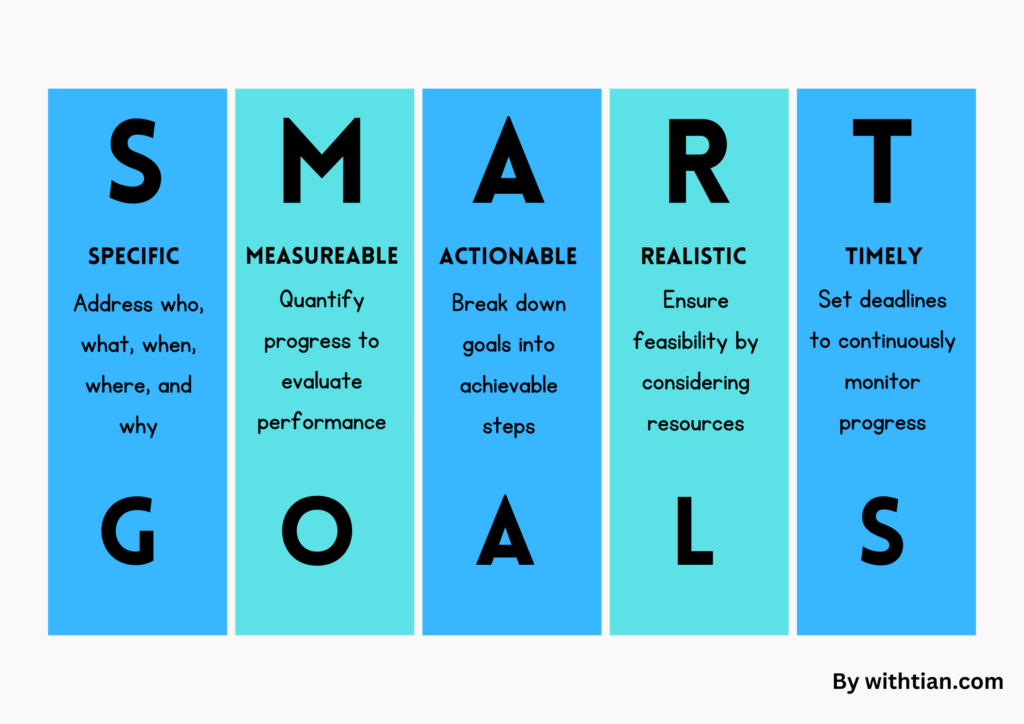
Have you ever found yourself enthusiastically setting goals, only to watch them fall by the wayside as the weeks pass? It’s a frustratingly common experience – the initial burst of motivation gradually fading away, leaving us wondering why we couldn’t stay the course. Perhaps the goals were too vague, the path too unclear, or the deadline too distant. Whatever the reason, this cycle of setting goals and then struggling to achieve them can feel like an uphill battle. But don’t worry, because there’s a solution: SMART goals.
What Are SMART Goals?
SMART goals are a structured approach to goal-setting that is Specific, Measurable, Actionable, Realistic, and Timely. This acronym provides a framework for creating objectives that increase the likelihood of success. Let’s break down each component of the acronym.

Specific: S in SMART Goals
As we embark on our journey toward realizing our dreams, it’s crucial to establish a clear roadmap. This is where specificity becomes essential. We need to define our goals precisely, reducing ambiguity. Who will be part of this journey? What exactly are we aiming to achieve? Where will we focus our efforts? Also, why does this goal matter? Addressing these questions upfront sets a solid foundation for action.
Measurable: M in SMART Goals
Once our goals are defined, the next step is establishing how we’ll measure our progress. Picture it as setting up signposts on our journey – they actively inform us of the distance covered and how much lies ahead. What metrics or criteria will we employ to gauge our success? In other words, how will we actively track our progress? Equally important, how often will we assess our performance and make necessary adjustments? By setting measurement criteria, we hold ourselves accountable and steer ourselves toward our desired outcomes.
Actionable: A in SMART Goals
With our goals clearly defined and our measurement criteria established, it’s time to take action. But where do we start? This is where actionable steps come in. What specific actions are required to propel us closer to our goal? Think of it as laying the cornerstone for our journey toward success. We’ll proceed step by step, breaking down our goals into manageable tasks. By doing so, we ensure a clear and direct path to success.
Realistic: R in SMART Goals
While a healthy dose of ambition is beneficial, we must ensure our goals match what we can realistically achieve with our resources, time, and circumstances. Are the resources (e.g., money and skills) available to realize this goal? Additionally, are there any potential obstacles or challenges that must be addressed? It’s also crucial to avoid falling into the trap of black-and-white thinking. When we succumb to this type of thinking, we often set unrealistic expectations for ourselves, believing that success must be achieved perfectly, or it’s not worth pursuing at all. Instead of setting ourselves up for disappointment, let’s embrace a more flexible approach, recognizing that progress often comes in incrementally.
Timely: T in SMART Goals
Lastly, let’s set deadlines. This not only holds us accountable but also ignites momentum and motivation. When do we intend to achieve our goal? And what makes this deadline crucial? By establishing clear timelines, we ensure consistent progress.
Summary
To tie this together, achieving our goals requires more than good intentions. It demands specificity, progress tracking, actionable steps, realistic planning, and a healthy sense of urgency. With determination and a well-executed plan, little can hinder our success.